Roof garden design brings a slice of nature to urban living, offering a refreshing retreat right above the hustle and bustle. It’s all about creating functional and beautiful spaces that maximize your roof’s potential, turning it into a relaxing oasis or a vibrant garden. With the right plants, layout, and features, you can transform your rooftop into an inviting space for relaxation, entertainment, or even gardening.
Comfortable Seating Areas for Relaxation
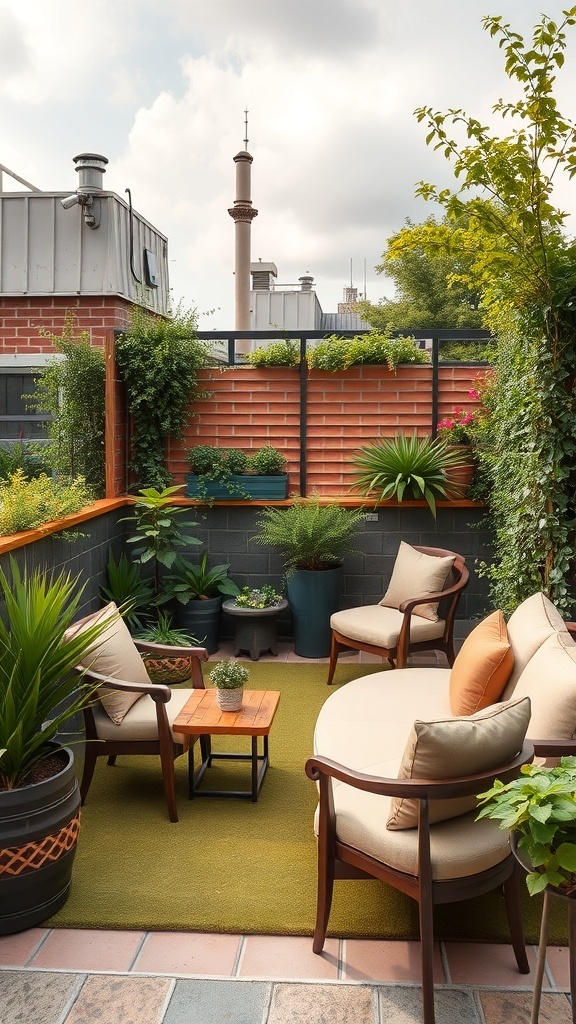
Creating a cozy seating area in your roof garden can transform it into a relaxing retreat. The image shows a charming setup with comfortable chairs and a small table, perfect for enjoying a morning coffee or unwinding after a long day.
The soft cushions on the chairs invite you to sit back and relax. The green rug adds a touch of warmth, making the space feel inviting. Surrounding plants bring life and a bit of nature to the area, enhancing the overall vibe.
Consider adding a few decorative elements like cushions or throws to make the seating even more inviting. A small table is great for holding drinks or snacks, making it a perfect spot for casual gatherings with friends or family.
With the right seating, your roof garden can become a favorite spot for relaxation, offering a peaceful escape from the hustle and bustle of daily life.
Lighting Solutions for Evening Ambiance
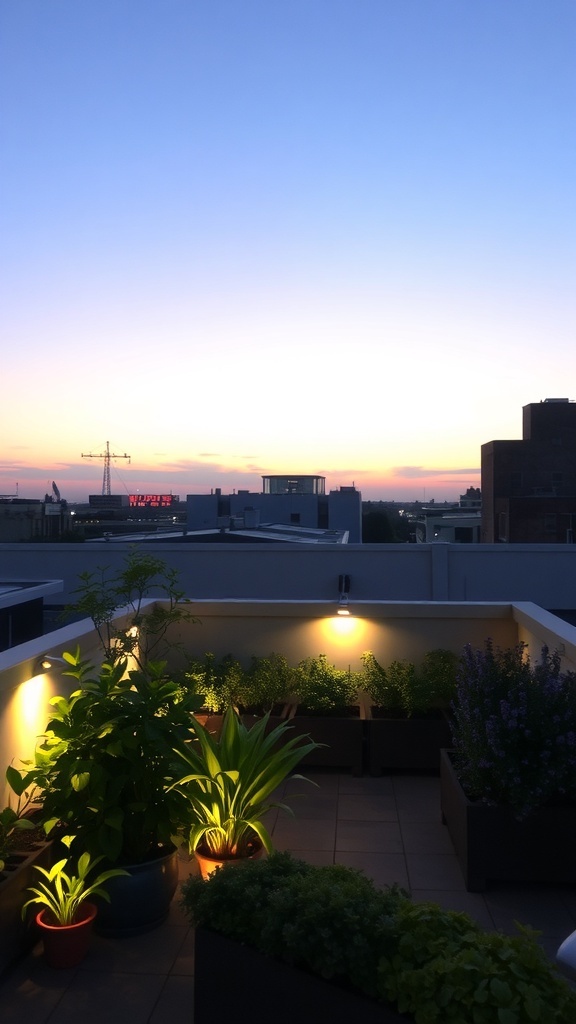
Creating a cozy atmosphere on your roof garden is all about the right lighting. The image shows a beautiful rooftop space just as the sun sets, casting a warm glow over the plants. The soft lights highlight the greenery, making it inviting for evening relaxation.
Using warm LED lights can enhance the natural beauty of your plants. They not only provide enough illumination but also create a soothing vibe. Consider placing lights strategically to draw attention to your favorite plants or seating areas.
Incorporating different types of lighting, like wall-mounted fixtures and potted plant lights, adds depth to the space. This variety can transform your rooftop into a charming retreat. Remember, the goal is to create a space where you can unwind after a long day.
Don’t forget about solar lights! They’re eco-friendly and can add a whimsical touch to your garden. With the right lighting solutions, your roof garden can become a magical spot for evening gatherings or quiet moments under the stars.
Innovative Water Features for Rooftop Gardens
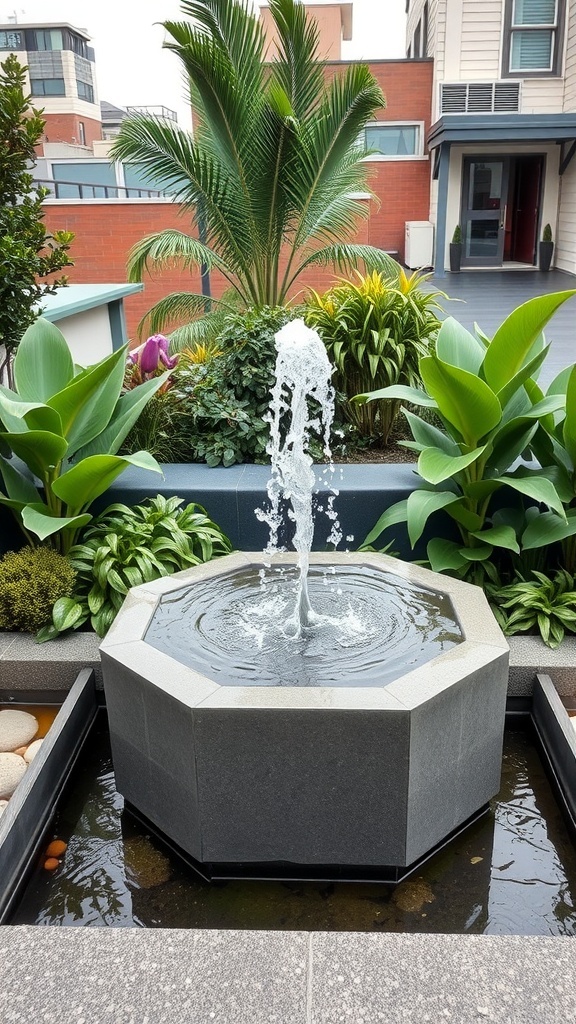
Water features can really bring a rooftop garden to life. The image shows a stylish octagonal fountain that adds a modern touch to the greenery around it. The gentle flow of water creates a soothing sound, making the space feel more tranquil.
Incorporating a fountain like this not only enhances the visual appeal but also attracts birds and butterflies, adding to the garden’s charm. The surrounding plants, with their vibrant green leaves, complement the fountain beautifully, creating a lush atmosphere.
When designing your rooftop garden, think about how water features can fit into your overall plan. They can be a focal point or a subtle addition, depending on your style. A well-placed fountain can transform a simple garden into a serene retreat.
Maximizing Space with Vertical Gardening
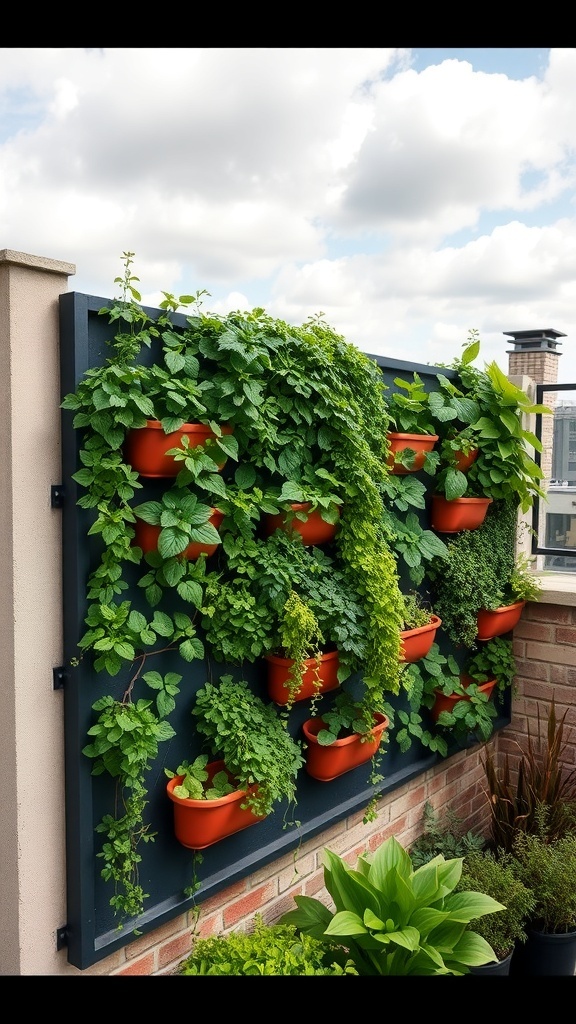
Vertical gardening is a fantastic way to make the most of limited space, especially in a roof garden. The image shows a vibrant wall of greenery, filled with various plants in bright orange pots. This setup not only looks great but also allows for easy access to herbs and flowers.
Using vertical space helps create a lush environment without taking up too much room. The plants cascade down, adding texture and life to the area. Herbs like mint and basil thrive in this arrangement, making it perfect for those who enjoy cooking with fresh ingredients.
Setting up a vertical garden can be simple. You can use wall-mounted planters or even repurpose old pallets. This approach not only saves space but also adds a unique touch to your roof garden. Plus, it’s a fun project that can be tailored to your style and preferences.
Creating a Lush Urban Oasis
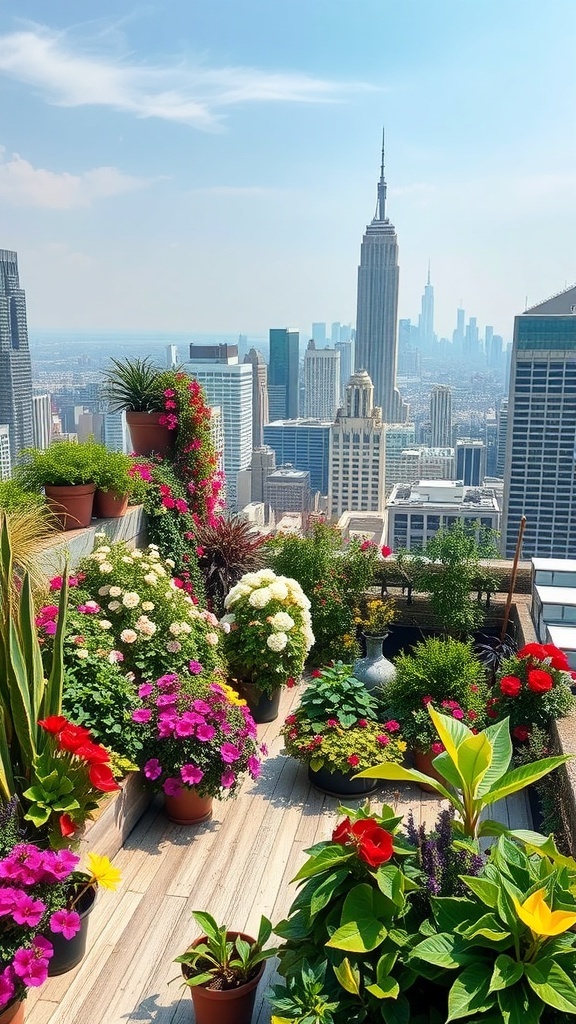
Imagine stepping onto a rooftop filled with vibrant flowers and greenery, all while surrounded by the stunning skyline of a bustling city. This image captures the essence of a roof garden, where nature meets urban life. The colorful blooms in pots create a cheerful atmosphere, inviting anyone to relax and enjoy the view.
The mix of plants adds texture and depth, making the space feel alive. From bright petunias to lush ferns, each plant plays a role in creating a serene escape. This rooftop garden not only beautifies the space but also offers a breath of fresh air amidst the concrete jungle.
Having a roof garden is more than just aesthetics. It provides a place to unwind, grow your own herbs, or even host small gatherings. The contrast of greenery against the city backdrop makes it a unique spot to enjoy nature without leaving the urban environment.
Edible Gardens: Growing Your Own Food Above the City
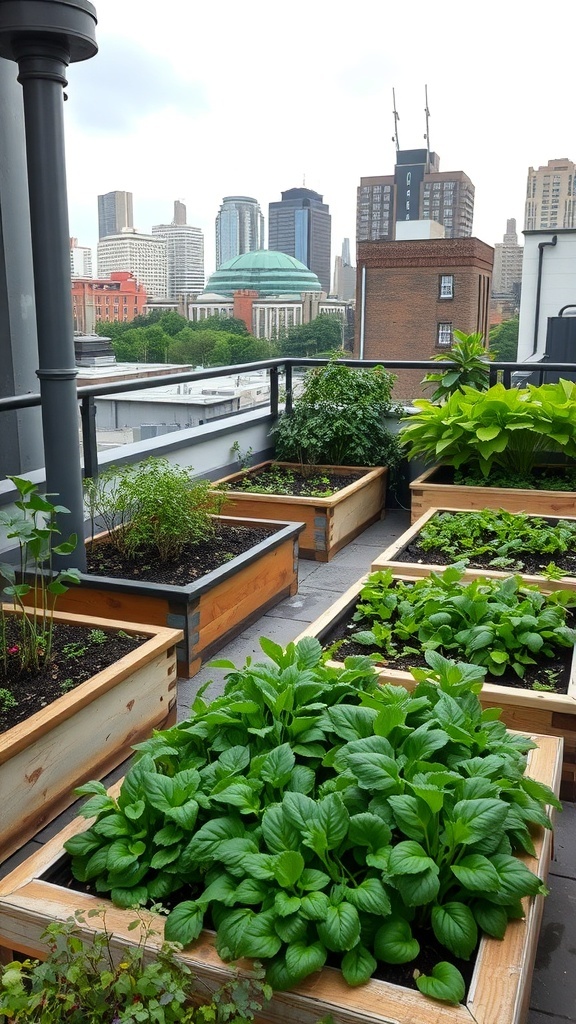
Imagine stepping out onto your rooftop and being greeted by a lush garden filled with vibrant greens. This image showcases a beautiful rooftop garden, complete with wooden planters brimming with leafy vegetables and herbs. The skyline in the background adds a unique urban touch, reminding us that fresh food can thrive even in the heart of the city.
Creating an edible garden on your roof is not just practical; it’s also rewarding. You can grow your own salads, herbs, and even some fruits. The planters in the image show a variety of plants that are easy to maintain and perfect for small spaces. Think about incorporating leafy greens like lettuce and spinach, which can be harvested multiple times.
Rooftop gardens also provide a great opportunity to connect with nature. Tending to your plants can be a relaxing escape from the busy city life below. Plus, there’s nothing quite like the taste of fresh produce that you’ve grown yourself. You can enjoy the satisfaction of knowing exactly where your food comes from.
To get started, consider what you’d like to grow based on your cooking habits. Herbs like basil and cilantro are fantastic for adding flavor to dishes. For a simple salad, mix in some homegrown tomatoes and cucumbers. The possibilities are endless!
Sustainable Plant Choices for Roof Gardens
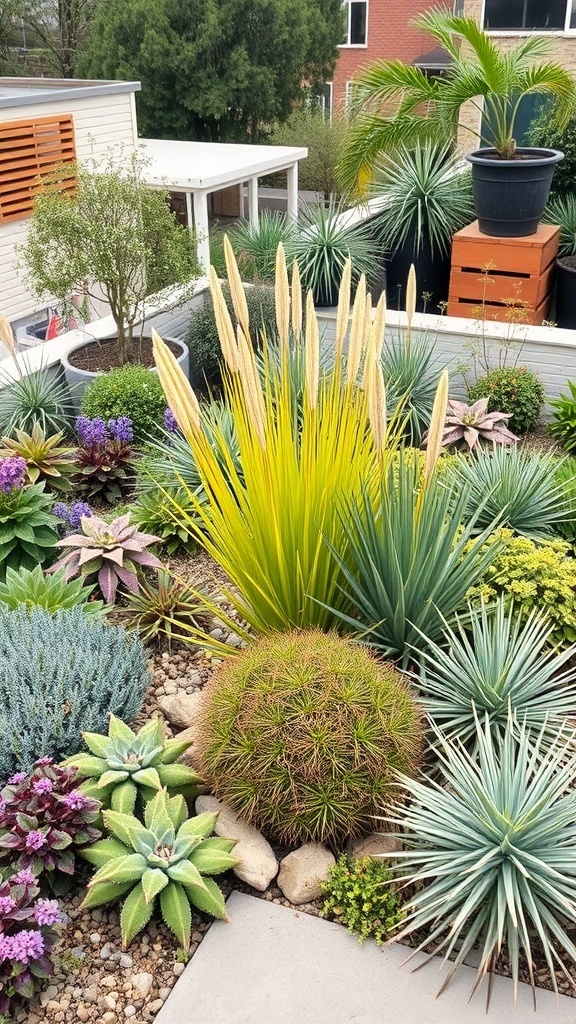
Creating a roof garden is a fantastic way to bring nature to urban spaces. Choosing the right plants is key to sustainability. In the image, you can see a vibrant mix of plants that thrive in rooftop environments.
Succulents and cacti are popular choices for roof gardens. They require minimal water and can handle the heat. The spiky green plants in the picture are great examples. They add texture and interest while being low-maintenance.
Another smart choice is native plants. They adapt well to local conditions and support local wildlife. The colorful foliage in the image shows how diverse these plants can be. They not only look good but also help the environment.
Don’t forget about herbs! They can be both decorative and functional. Imagine having fresh basil or mint right at your fingertips. Plus, they attract beneficial insects, which is a bonus for any garden.
Incorporating a variety of plants, like those shown, creates a balanced ecosystem. This approach not only makes your roof garden beautiful but also sustainable. So, when planning your roof garden, think about these plant choices for a greener future.
Incorporating Art and Decor in Roof Gardens
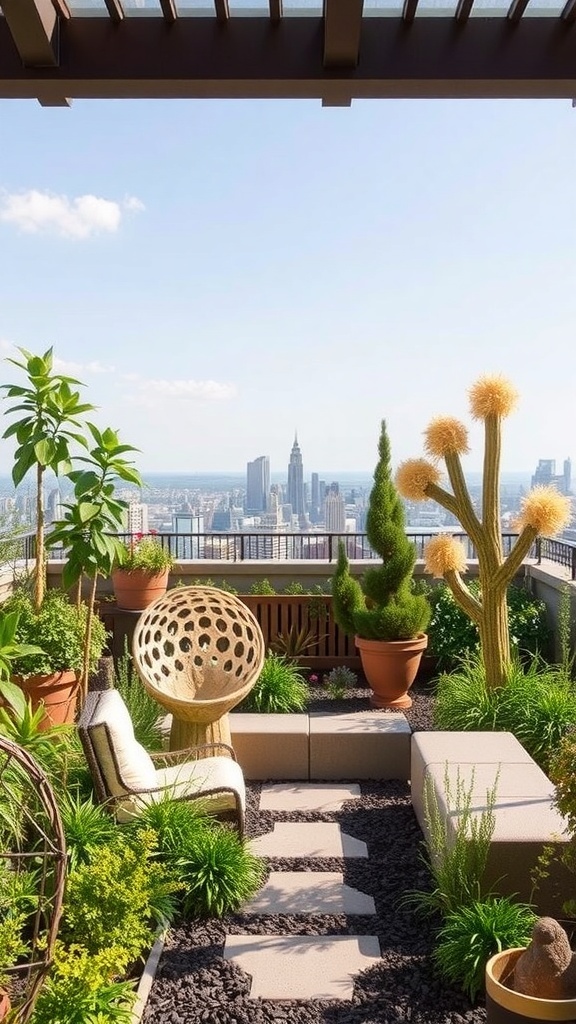
Creating a roof garden is not just about plants; it’s also about adding personality through art and decor. The image shows a vibrant rooftop space filled with greenery and unique sculptures. These elements bring life and character to the area.
Notice the playful use of statues, which serve as focal points. They invite curiosity and conversation. The mix of textures from the plants and the smooth surfaces of the sculptures creates a balanced look. This combination makes the garden feel both lively and serene.
Incorporating various decorative pieces can enhance the overall design. For instance, the tall palm adds height and a tropical vibe, while the colorful flowers provide pops of color. This thoughtful arrangement draws the eye and encourages exploration.
When designing your roof garden, think about how art can reflect your style. Whether it’s modern sculptures or classic statues, each piece can tell a story. This personal touch transforms a simple garden into a unique retreat.
Wind Protection Strategies for Rooftop Gardens
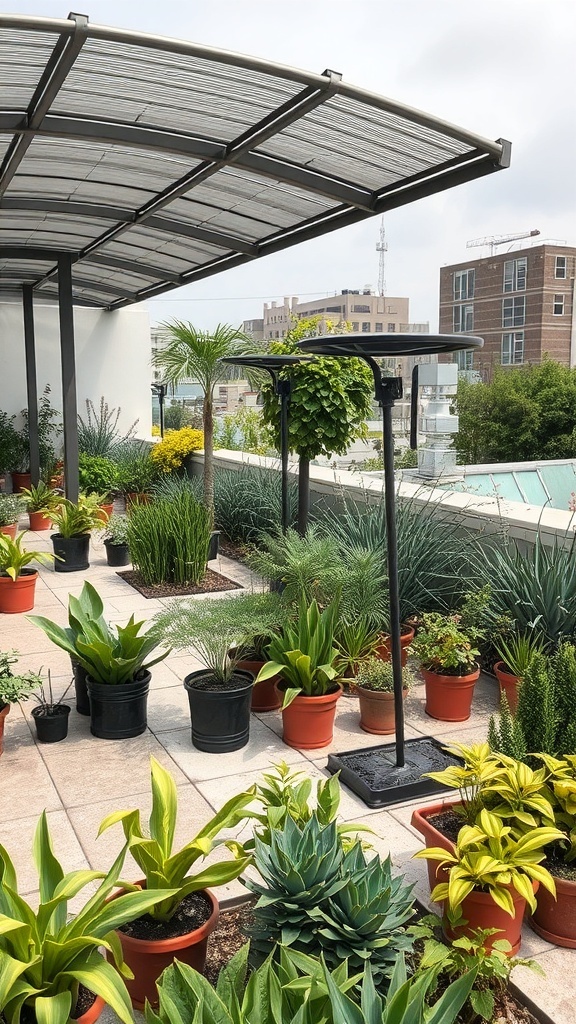
Rooftop gardens can be a fantastic escape in the city, but wind can be a real challenge. The image shows a lovely rooftop garden filled with various plants in pots, all under a protective canopy. This setup not only adds beauty but also helps shield the plants from harsh winds.
One effective strategy for wind protection is to use tall plants or structures as natural barriers. In the image, you can see how the arrangement of plants creates a cozy atmosphere. Taller plants can block gusts and create a more stable environment for smaller ones.
Another option is to install windbreaks, like screens or trellises. These can be placed strategically to redirect wind away from your garden. The canopy in the image serves a similar purpose, providing shade and reducing wind exposure.
Lastly, consider the layout of your garden. Grouping plants together can help create microclimates where they can thrive despite the wind. The diverse plant arrangement in the photo highlights how thoughtful placement can enhance both aesthetics and protection.
Seasonal Changes and Maintenance Tips for Roof Gardens
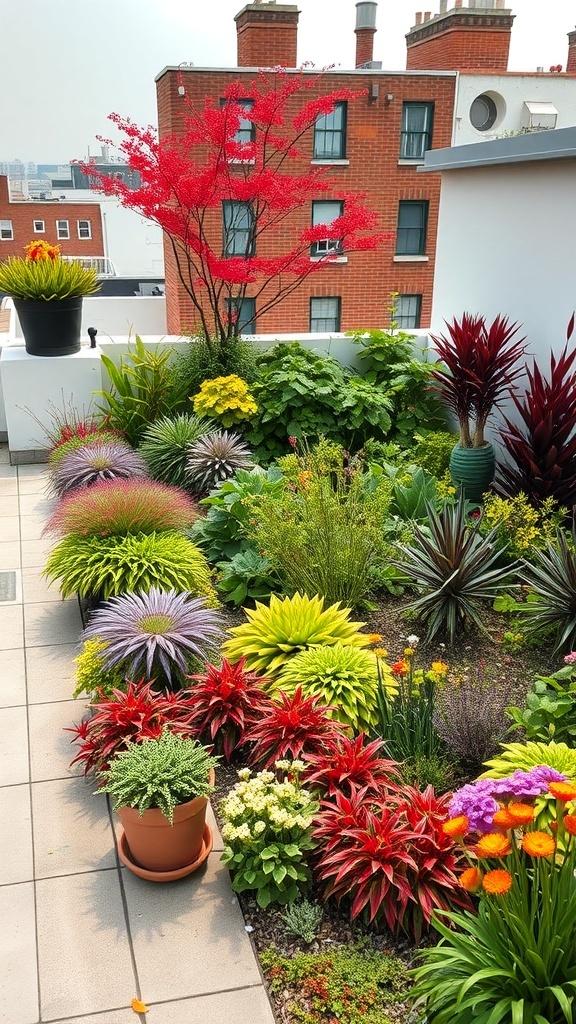
Roof gardens can be a stunning addition to any home, offering a slice of nature high above the ground. The image shows a vibrant roof garden filled with colorful plants, showcasing the beauty that can be achieved. Seasonal changes can greatly affect these gardens, so understanding how to maintain them is key.
In spring, this garden bursts with life. Regular watering and fertilizing will help plants thrive as they wake from winter dormancy. Pay attention to the specific needs of each plant, as some may require more sunlight or water than others.
As summer approaches, the heat can be intense. Ensure your plants are well-hydrated, especially those that are more sensitive to drought. Mulching can help retain moisture and keep roots cool. This garden’s lush greenery is a great example of how to create a cooling effect in urban settings.
When autumn arrives, it’s time to prepare for the colder months. Pruning dead leaves and spent flowers will keep the garden tidy and promote healthy growth for the next season. Some plants may need to be brought indoors or covered to protect them from frost.
Winter can be tough, but many plants can survive with a little care. Consider using frost cloths for protection and ensure that any pots are elevated to prevent waterlogging. The vibrant red tree in the image hints at the beauty that can still be found in winter.
Overall, maintaining a roof garden requires attention to seasonal changes. With the right care, your garden can flourish year-round, providing a beautiful escape from the urban environment.
